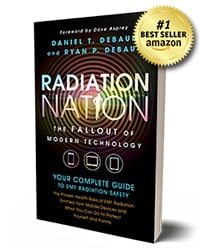Your cart is currently empty!

US National Toxicology Program (NTP) Study Shows Cell Phone Radiation May Lead to Cancer
Last Updated on February 20, 2024

We’ve heard it before. “Cell phone radiation causes cancer.”
It seems like the newsflash that keeps on re-occurring every few years with a fresh wave of headlines.
Today is no exception, yet this time there is a difference.
A multi-million dollar government-funded study conducted by the US National Toxicology Program (NTP) shows how cell phone radiation can lead to tumor formation.
This was never shown before.
Cell phones were invented in the ’70s and went to market in the ’80s. By the ’90s, the news was reporting on studies which demonstrated cell phone users developed higher rates of brain cancer not seen in the non-cell phone using population.
A lot of fear and confusion ensued, but public concern eventually died down as no definitive “proof” of how cell phone radiation actually caused cancer was immediately determined.
Experts hesitated to make a judgment. Certainly, there was a consensus that statistical correlation between cell phones use and cancer exists, but the amount of data available for analysis was deemed too limited. There were so few people who actually used cell phones back then, let alone for prolonged periods of time.
Since then, cell phone use proliferated. As data grew, government agencies became cautious.
In 2011, the World Health Organization’s International Agency for Research on Cancer classified Radio Frequency (RF) electromagnetic fields, emitted from cell phones and other wireless devices, as “possibly carcinogenic to humans.“
A panel of 31 experts from 14 countries placed RF radiation in “Group 2B” along other substances that include lead, nickel, and gasoline. Their websites listed numerous qualifiers and cited on-going research.
As Dr. Joel Moskowitz, Director of the Center for Family and Community Health at the University of California at Berkeley put it, “A lot of scientists have come round to the view that radiofrequency radiation is probably carcinogenic because of new research that has emerged since 2011.”
In the last twenty years, numerous studies have been conducted. For the first time though, scientists know how cell phone radiation can alter the living body. They now have their proof from mice subjected to Electromagnetic Radiation.
What the NTP US Government Study Found
Concluding in 2016, a major in-depth peer-reviewed study was conducted by the US National Toxicology Program (NTP). More than 2,500 rats were exposed to varying levels of RF radiation – one type of radiation emitted by cell phones.
Radiation exposure exhibited a directed dose-response relationship, as in the more radiation rats received the higher amount of rare brain and heart cancer they developed.
Tumors were not found in rats not exposed to the radio frequencies.
In the report released alongside the study, researchers noted “Given the widespread global usage of mobile communications among users of all ages, even a very small increase in the incidence of disease resulting from exposure to [wireless radiation] could have broad implications for public health.”
The study, which cost the US government 25 million dollars and carried out over 10 years, is considered to be accurate and well designed by leading health authorities, is one of the largest and most in-depth analysis of mobile phones and cancers conducted to date.
How Cell Phone Radiation Works
Cell phone radiation is “non-ionizing,” which has been presumed safe. Unlike ionizing radiation such as X-Rays, non-ionizing radiation is associated with extremely low energy.
In non-ionizing radiation, there is insufficient energy to break chemical bonds as ions cannot form. Therefore, it was always assumed that the power generated by cell phones and other electronic devices would be too weak to produce heat and could not cause biological effects whatsoever.
This was proven to be wrong.
“For years, the understanding of the potential risk of radiation from cell phones has been hampered by a lack of good science. This report from the National Toxicology Program (NTP) is good science….the findings are unexpected; we wouldn’t reasonably expect non-ionizing radiation to cause these tumors. This is a striking example of why serious study is so important in evaluating cancer risk.”
When living cells couple with radiation, the cells behave differently. Cells respond to changes in radiation. Some of the effects can be reactions like the movement of calcium across membranes or the production of free radicals or a change in the expression of genes in a cell. Important proteins can be expressed in places and times and amounts that they shouldn’t be. This can result in a dramatic effect in the function of cells.
Back in the ’90s, biochemist Jerry Phillips conducted Motorola-funded research into the potential health impacts of cell phones. Phillips and his colleagues studied the effects of different RF signals on rats and on cells in a dish while trying to understand the mechanism of action.
According to Phillips, “the most troublesome finding to Motorola at the time is that these radiofrequency signals could interact with living tissues, which is what we saw in the rats [then and again today]“.
As Phillips put it, “Some of these changes are consistent with what’s seen when cells undergo conversion from normal to malignant. These effects vary depending on the nature of the signal, the length of the exposure, and the specifics of the signal itself.”
These changes were seen in the rats exposed in the latest NTP study.
Although the researchers acknowledge more data is still needed, this study has been viewed as eye-opening.
As Otis W. Brawley, M.D., American Cancer Society Chief Medical Officer stated “For years, the understanding of the potential risk of radiation from cell phones has been hampered by a lack of good science. This report from the National Toxicology Program (NTP) is good science….the findings are unexpected; we wouldn’t reasonably expect non-ionizing radiation to cause these tumors. This is a striking example of why serious study is so important in evaluating cancer risk.”
While the NTP study was conducted on rats, there is evidence to suggest the same effect will occur in humans. This pre-clinical evidence mimics what may be expected to those of us who rely on our wireless devices heavily.
Protecting Yourself from Cell Phone Radiation
Modern technology is almost unavoidable in today’s age.
As Phillips advises, “People want to believe their technology is safe. I do. I would love to believe it, but I know better.”
Phillips recommends taking steps to avoid potential health hazards; some as simple as avoiding holding his cell phone to his ear as well as texting and using speakerphone. Other tools can be implemented though. His conclusion is simply that the public needs to be informed.
Certainly, current research is building that cell phone radiation is a force not to be taken lightly. If this NTP study is to be used as any kind of warning, it is that cell phone radiation and other wireless radiation exposure should not be presumed to be safe and measures should be taken to prevent unnecessary risk.
Related Posts
None found



























